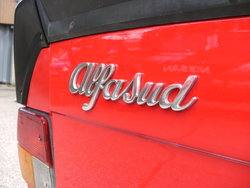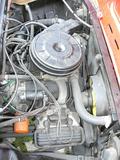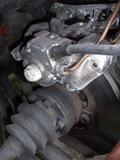The Alfa Sud 1.2 Ti
The key to that extra 5 bhp, the twin choke carb
The engine bay in all its glory
The inboard front brakes

07/08/2012
I have got one, I have finally got one, the car that got me into Alfas. I am now the proud owner of an Alfa Sud and it isn't just any Sud, it is an Alfa Sud 1.2 Ti. Now back in the day, it wasn't this model that converted me from the Anglo Saxon offerings of the time, it was a series 2 1500 Ti but it is near enough. The shock of having to pay more than the original list price for the car and then on top of that having to send it straight to my body shop and spending the same again on the paintwork was a little bit daunting but has now worn off!
Now that it's finished I am beginning to enjoy classic motoring again. While I used to think that an Alfa Sud was the fastest car round a corner that existed on the planet, now things have moved on. 165/70-13 tyres are just not cutting edge technology in fact it is really quite slow compared to any modern car. The thing that sets it apart is the ease with which you can use the cars whole potential. It doesn't matter that the tyres are squealing like a banshee because it is totally predictable, who needs 4 wheels, she is quite happy cornering on three!
The engine is also a joy, its 1186 cc and 68 BHP are nothing to write home about but she will sit all day at 6000 rpm and that equates to almost exactly 100 miles per hour which is just enough to stop you from getting hassled on the motorway. Having said that for the size of the engine it isn't far off the pace when compared with modern normally aspirated cars even with all their fuel injection systems and multiple valves. However the miles per gallon is appalling, I don't think I have got over 35 to the gallon yet! To get the HUGE jump in power from 63 bhp on the standard car to the Ti's massive 68 bhp Alfa Romeo upped the compression ratio to 9.0-1 and fitted a twin-choke, down draught carb that sits in the middle of the engine bay.
Designed by Rodolfo Hruska the Alfa Sud is still in a class of its own dynamically, there is nothing on the market today that has such an advanced chassis design which is a bit of a shame. Cars today in this class tend to conform to an almost universal pattern, they will be an inline 2,3 or 4 cylinder engine, they will have a Macpherson strut front suspension with some sort of dead rear axle (probably similar to a golf), it will have outboard front disks (to increase the un-sprung weight!) and drum brakes on the rear. It is almost as if manufacturers are frightened to deviate from this plan and it is mainly down to having to make cars to a price. The Sud however is different, it is designed to work dynamically. The use of the flat-four engine puts the weight low in the chassis, significantly lowering the centre of gravity of the car, also because a flat-four is significantly shorter than an inline-four the weight of the engine is much nearer the axle line which helps to reduce understeer. The more weight there is further from the centre of gravity of the car the more of a problem there is stopping it from going straight on and the more difficulty there is turning it (think of dumbbells). The gearbox is positioned behind the differential which also helps to bring the weight back in the chassis while also shortening and simplifying the gear lever mechanism. The engine itself is designed for ease of maintenance, the cylinder heads can be removed without taking the engine out of the chassis, this is achieved while running the chassis rail no more than 2 cm from them. The pistons can also be removed without taking the engine out of the car, on most flat-four engines you have to remove the engine from the car and then split the crankcase in order to remove a piston.
While the engine is pretty nice it was never the Alfa Sud's trump card, after all, Alfa Romeo had been making their twin-cam engines in various guises virtually from 1910 and they are a work of art compared with the single overhead cam Sud engine, it was the handling that was always the delight. Upfront there is a simple Macpherson strut but as usual, the devil is in the detail, the shock absorber is mounted upside down so all of the weight in the shock absorber is mounted on the chassis, not on the suspension. The brake disks and callipers are mounted inboard on the side of the gearbox, again this is to reduce the un-sprung weight of the car. By now some of you must have got bored with me banging on about unsprung weight and may be wondering why it matters. Un-sprung weight is any part of the car that is in direct contact with the road and not separated from it by the road spring so in most cases it will include wheel, tyre, hub, brake, shock absorber and suspension arms. Now when you are cruising along in your car and the suspension is moving up and down relative to the car, the heavier the suspension is relative to the car the more it will move the car body. Think of it like this, if I were to throw a feather at you, try as I might I won't be able to make you move. However, if I throw a large rock at you, you will go reeling backwards. It is exactly the same with a car body, the heavier the suspension is when the car hits a bump, the more energy it will transfer to the car body and the more the car body will move. Moving all the weight from the suspension to the body also helps to increase the mass of the car body relative to the mass of the suspension, all of which also helps to improve the ride quality.
At the rear of the car, similar techniques are used to reduce the weight, so the shock absorber is mounted upside down and the beam axle is made of a lightweight box section. However, as there are no drive shafts you cant mount the brakes inboard easily so at the rear the Sud has outboard disk brakes, this is still unusual today but it was almost unique on a small car of its day. The rear beam axle is located laterally by a Panhard rod, not as exotic as the watts linkage used on an Alfetta but simple and efficient. While the axle is located fore and aft by two links on either side, one acting in an arc from in front of the axle and the other one acts in an arc from behind the axle. As the rear axle moves up and down it is forced to rotate but as the car rolls while cornering, one side of the axle rises while the other side falls, this forces the axle to twist which effectively reduces roll.
Inside the car, things become slightly eccentric, in fact, I don't think anyone knows how the switchgear works. The right-hand control switch controls the interior fan, obviously an essential switch to have at your fingertips, while the choke light doubles as the brake failure light. Imagine the thought process when driving down the motorway; my brakes have failed OMG we are going to die or have I just left the choke on, or worse “look I have left the choke on†as you crash into the stationary car in front with no brakes!
So what went wrong with the Sud and why isn't as revered today in the same way that 105 series cars are, the answer is simple, build quality. No one in their right mind buys a car that will fail its first MOT due to rust which the Sud actually did, they did actually dissolve in front of your eyes that is what makes this Sud 1.2Ti so rare. How this one survived I don't know but somehow it has been loved all its life and it has survived almost perfectly intact, now it is my turn to help preserve this tiny bit of Alfa Romeo history, wish me luck and good welding!
10/09/2009
The Alfasud is another of my favourite Alfa Romeos. It is the most dynamically advanced small to medium size car ever produced; now that is quite a claim and I fully expect you to try and correct me on this, so you know my email address, go for it, but before you do let me explain why the Sud is so good.
The car was designed by Rudolf Hruska and styled by Giorgio Giugiaro and was unusual in that Hruska was given a clean sheet of paper to both design and build the car.
The location of the new factory was on the Pomigliano d'Arco site in Southern Italy, hence Alfasud, or Alfa South in English. This was to prove to be somewhat of a double-edged sword when it came to the production of the car, but the design itself is brilliant. The project was started in 1967 and it took 4 years to complete. Hruska was an ex Porsche engineer and much of the design was influenced by his early experience there. The car uses a flat 4 engine, the advantages of which are that the weight of the engine is only just in front of the axle line and carried low in the chassis. The other option of an in-line 4 would take the weight of the car further forward and raise the car's centre of gravity. The engine was mounted longitudinally, so negating the need to dampen the torque effects of a transverse engine.
The gearbox is mounted in line with the engine but behind the differential. Mounting the gearbox along the centre line allows the use of equal length driveshafts which helps eliminate the effects of torque steer while putting the differential in front of the gearbox both reduces the front overhang of the engine and reduces the length of the gear linkage. The car, even in its early 1186 cc guise, had disk brakes all round, the front brakes being mounted inboard to reduce unsprung weight.
In order to further reduce the unsprung weight of the car, the shock absorbers are mounted upside down which is very unusual. The rear beam axle is quite interesting as it serves two purposes, the first being a very simple way to keep the wheels perpendicular to the road, and the second is it also serves as a roll bar; the longitudinal links twist the axle as it rises and falls and helps to control the roll of the car. The axle is located laterally by a Panhard rod.
The engine is designed with maintenance in mind; the cylinder heads are removable in situ and it is possible to do quite major repairs to the bottom end without the needing to remove the engine. The tappets are adjustable with a simple cam and Allen key, while the serrated main bearing caps prevent the engine from splitting apart.
The car was released at the 1971 Turin motor show and was an instant success the combination of 63 bhp in a chassis weighing 830 kg gave the car enough performance to be interesting. However, the base model was soon followed by the Ti this pushed power up to 68 bhp and together with a rear spoiler, lower-profile tyres and a host of other sports equipment soon made this the choice of the sporting driver. The design was revamped twice with the series 2 getting wrap round headlamps and the series 3 got a proper hatchback. The final incarnation of the Alfasud Ti had a 1500 cc flat-four engine producing 105 bhp fed by twin, twin-choke downdraft carburettors.
During its lifetime the Alfasud had a number of different incarnations with 3, 4 and 5 doors becoming available, and even an estate being produced. Probably my favourite is the series 2 1500 Ti; the body being slightly stiffer than the later hatchback and the 95 bhp engine is just slightly less cammy or it may be that I just have fond memories of that car...
JP
Related Links: Car Registration Letters | History of the Alfa Romeo Badge | Alfa Romeo Insurance Advice




